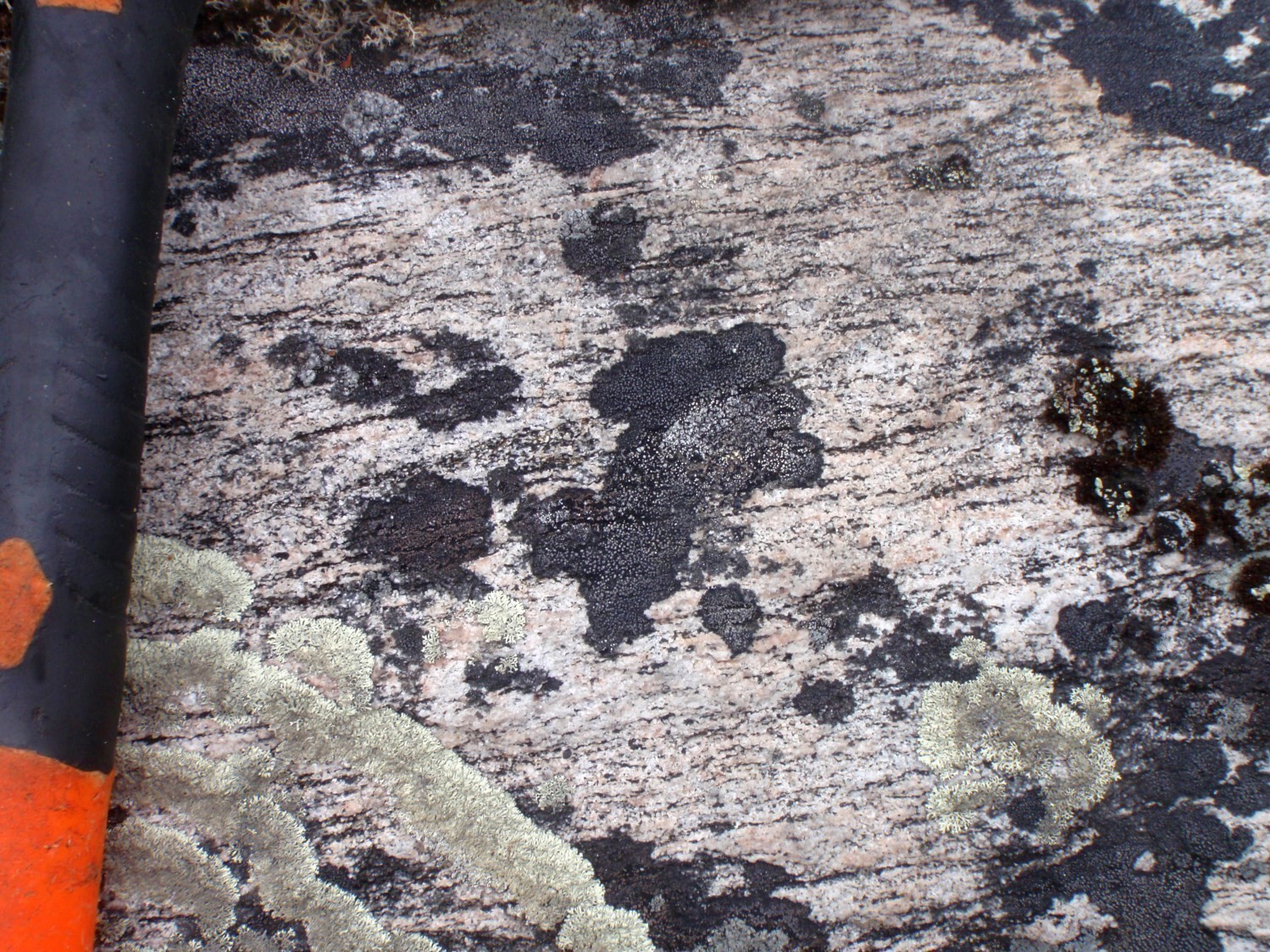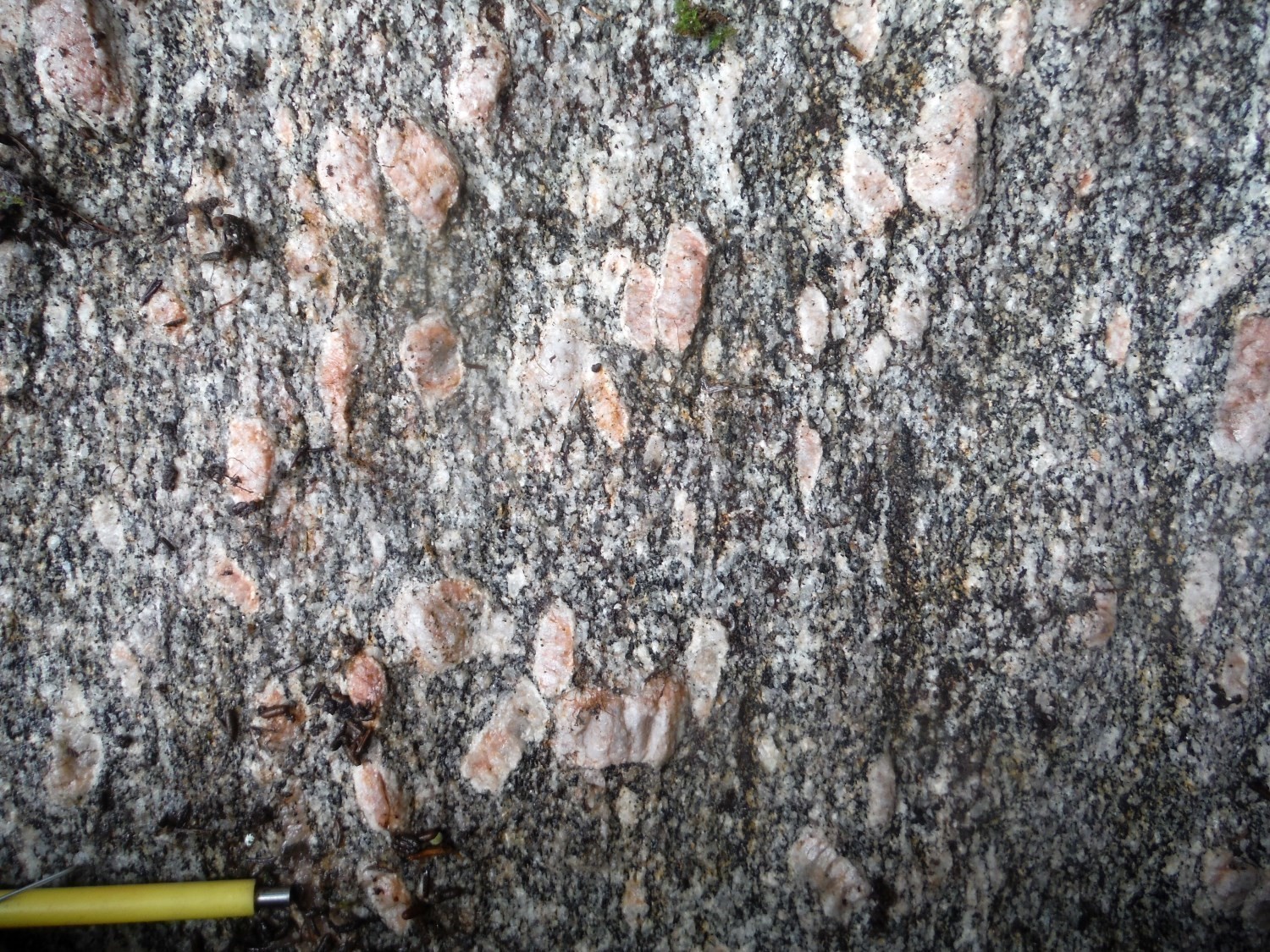
DISCLAIMER: This English version is translated from the original French. In case of any discrepancy, the French version shall prevail.
| Author: | Bourque, 1986 |
| Age: | Paleoproterozoic |
| Stratotype: | None |
| Type area: | Mina Lake area (NTS sheets 23P13, 23P14, 24A03 and 24A04) |
| Geological province: | Churchill Province |
| Geological subdivision: | Baleine Lithotectonic Domain |
| Lithology: | Metamorphosed biotite-hornblende potassic intrusive rocks |
| Category: | Lithodemic |
| Rank: | Suite |
| Status: | Formal |
| Use: | Active |
None
Background
The Champdoré Suite was first named “Lac Champdoré Granodiorite” following the work of Bourque in the Mina Lake area during the summer of 1985 (Bourque, 1986, 1991). This unit was extended southward in the Recouet Lake area by Danis (1988). In the Jeannin Lake area, Charette et al. (2016) formally renamed it “Champdoré Suite” to comply with the North American Stratigraphic Code. The unit was also extended southward in the Résolution Lake area as part of the Southeastern Churchill Province synthesis (Lafrance et al., 2020).
Description
The Champdoré Suite consists of two units: granodiorite, monzogranite and quartz monzodiorite (pPchm1), and fine-grained pink granite (pPchm2).
Champdoré Suite 1 (pPchm1): Variably Recrystallized Granodiorite, Quartz Monzodiorite and Monzogranite
Unit pPchm1 consists of granodiorite, monzogranite and quartz monzodiorite and represents the main unit of the Champdoré Suite. It includes different facies characterized by magnetism of varying intensity. The main facies is fine to medium grained and is characterized by a quartzofeldspathic matrix partially to fully recrystallized. The rock has a well-developed foliation, homogeneous appearance and colour ranging from light-medium grey to pinkish grey. A second facies having a gneissic texture is regularly observed with alternating millimetre to centimetre-wide leucocratic and mesocratic bands. Ferromagnesian minerals (7-25%) mark foliation and commonly form small elongated clusters or discontinuous laminations. Brown to greenish biotite (15-20%) and hornblende (5-15%) contain many zircon inclusions. Accessory minerals are abundant and include sphene, epidote (zoisite and pistachite), allanite, apatite and opaque minerals. Clinopyroxene, muscovite, chlorite and hematite are observed more locally. A third facies characterized by hornblende ± biotite black speckles was also observed locally. The whitish grey rock is normally poorer in K-feldspar (3-10%), not magnetic, and displays weak to moderate foliation.
According to Bourque (1991), the development of gneissosity is more important at the edge of the unit, which is closer to contact with diatexites and migmatized paragneiss of the Winnie and False suites. Locally, the different facies of unit pPchm1 develop a protomylonitic texture with the formation of quartz bands, feldspar porphyroclasts and recrystallization tails. These rocks also contain small amounts of stretched enclaves or boudinaged layers of diorite and granoblastic gabbro and ultramafic rocks. These enclaves are small (<1 m) and have sharp contacts, with no reaction rims with the intermediate to felsic host rock. Rocks of unit pPchm1 are commonly cut by intrusions of pegmatitic granite and, in some areas, by decimetric to metric dykes unit pPchm2 granite.
Champdoré Suite 1a (pPchm1a): K-Feldspar Porphyroclastic Granodiorite, Quartz Monzodiorite and Monzogranite
A fairly common last facies is characterized by the presence of 10-25% microcline phenocrystals or porphyroclasts, and light pink orthose 0.5-4 cm long. It is generally impossible to separate the different facies observed because of their close association at the outcrop scale. However, it has been possible in some places to group the porphyritic facies in informal subunit pPchm1a, which forms decametric to kilometric plutons. Based on the close association between well-foliated or gneissic granoblastic rocks and less-deformed facies showing well-preserved igneous textures, Charette et al. (2016) were able to group these different facies into a single unit. This hypothesis was confirmed by the ages obtained in the different facies of the unit.
Champdoré Suite 2 (pPchm2): Fine-Grained Pink Granite
Unit pPchm2 granite is non-magnetic and brownish pink to orange in fresh exposure and white to pinkish in altered surface. It is homogeneous, massive or slightly foliated, even grained and fine to very fine grained (aplite). Igneous textures are well preserved, although there is slight recrystallization locally. Granite contains 2-10% ferromagnesian minerals, mainly dark brown to green biotite and green to blue-green hornblende. The main accessory minerals are epidote, chlorite, muscovite, garnet, allanite, sphene, apatite and zircon. Myrmekitic textures are commonly observed in thin sections.
Thickness and distribution
The Champdoré Suite is located in the SW portion of the Baleine Lithotectonic Domain and covers an area of ~1500 km2. In terms of area, unit pPchm1 is the largest (1454 km2) while subunit pPchm1a (67 km2) is much smaller. Unit pPchm2 (4 km2) forms only six plutons a few hundred metres wide.
Dating
Paleoproterozoic crystallization ages (1859-1837 Ma) were obtained in both porphyritic and granoblastic facies of the Champdoré Suite. These ages are contemporaneous to the emplacement of other intrusive units within the Baleine Domain, namely the Lhande Suite (1834 Ma), the Kaslac Complex (1835-1828 Ma), the De Pas Supersuite (1862-1805 Ma), the Kuujjuaq Pluton (1869-1833 Ma), as well as crystallization of diatexites of the Winnie Suite (1839-1838 Ma).
| Sample Number | Isotopic System | Mineral | Crystallization Age (Ma) | (+) | (-) | Reference(s) |
| 2015-IL-3160-A | U-Pb | Zircon | 1859 | 9 | 9 | Corrigan et al., personal communication, 2018 |
| 2015-MV-8066-A | U-Pb | Zircon | 1839 | 6 | 6 | Rayner et al., 2017 |
| U-Pb | Zircon | 1837 | 2 | 2 | Corrigan et al., 2018 |
Stratigraphic Relationship(s)
In the field, deformed facies of the Champdoré Suite are similar to rocks of the Saffray Suite. However, the magnetic signature of these two units is very different, with the Saffray Suite forming very strong magnetic anomalies oriented E-W to WNW. Archean crystallization ages obtained for the Saffray Suite (2696-2683 Ma) also make it possible to distinguish them.
The Champdoré Suite contains enclaves of ultramafic rock, diorite and gabbro similar to those of the Ralleau Suite, as well as paragneiss of the False Suite and metavolcanics of the Curot Suite. It is cut by granitic and tonalitic intrusions of the Aveneau and Dancelou suites. To the SW, the Champdoré Suite is bordered by the Lac Turcotte Fault, which represents the boundary between the Baleine and Rachel-Laporte lithotectonic domains.
Paleontology
Does not apply.
References
Publications available through SIGÉOM Examine
BOURQUE, Y., 1986. Géologie de la région du lac Mina, Nouveau-Québec. MRN; DP-85-30, 2 plans.
BOURQUE, Y., 1991. GEOLOGIE DE LA REGION DU LAC MINA (TERRITOIRE-DU-NOUVEAU-QUEBEC). MRN; ET 88-08, 49 pages, 4 plans.
CHARETTE, B., LAFRANCE, I., MATHIEU, G., 2016. Géologie de la région du lac Jeannin, Québec, Canada. MERN; BG 2015-01, 1 plan.
DANIS, D., 1988. GEOLOGIE DE LA REGION DU LAC RECOUET (TERRITOIRE DU NOUVEAU-QUEBEC). MRN; ET 86-11, 62 pages, 4 plans.
LAFRANCE, I., VANIER, M.-A., CHARETTE, B., 2020. Domaine lithotectonique de Baleine, sud-est de la Province de Churchill, Québec, Canada: synthèse de la géologie. MERN; BG 2020-07, 4 plans.
Other publications
CORRIGAN, D., WODICKA, N., McFARLANE, C., LAFRANCE, I., VAN ROOYEN, D., BANDYAYERA, D., BILODEAU, C., 2018. Lithotectonic framework of the Core Zone, Southeastern Churchill Province. Geoscience Canada; volume 45, pages 1-24. https://doi.org/10.12789/geocanj.2018.45.128
RAYNER, N.M., LAFRANCE, I., CORRIGAN, D., CHARETTE, B., 2017. New U-Pb zircon ages of plutonic rocks from the Jeannin Lake area, Quebec: an evaluation of the Kuujjuaq Domain and Rachel-Laporte Zone. Geological Survey of Canada, Current Research (Online) 2017-4, 14 pages. https://doi.org/10.4095/306180
Suggested Citation
Ministère de l’Énergie et des Ressources naturelles (MERN). Champdoré Suite. Quebec Stratigraphic Lexicon. https://gq.mines.gouv.qc.ca/lexique-stratigraphique/province-de-churchill/suite-de-champdore_en [accessed on Day Month Year].
Contributors
|
First publication |
Isabelle Lafrance, P.Geo., M.Sc. isabelle.lafrance@mern.gouv.qc.ca (redaction) Mehdi A. Guemache, P.Geo., Ph.D. (coordination); Thomas Clark, P.Geo., Ph.D.; James Moorhead, P.Geo., Ph.D. (lecture critique); Claude Dion, ing., M. Sc. (révision linguistique); Céline Dupuis, P.Geo., Ph.D. (English version). |
|
Revision(s) |
Isabelle Lafrance, P.Geo., M.Sc. isabelle.lafrance@mern.gouv.qc.ca (redaction; 06/08/2019) Mehdi A. Guemache, P.Geo., Ph.D. (coordination); Simon Auclair, P.Geo., M.Sc. (editing); Céline Dupuis, P.Geo., Ph.D. (English version); Yan Carette (HTML editing). |
5 février 2020




